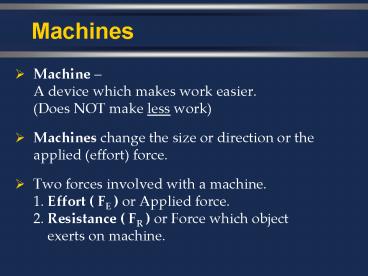Machines - PowerPoint PPT Presentation
1 / 19
Title:
Machines
Description:
Machines change the size or direction or the applied (effort) force. ... In an ideal machine (no friction) WI = Wo ... of different sizes. Axle: smaller wheel. ... – PowerPoint PPT presentation
Number of Views:34
Avg rating:3.0/5.0
Title: Machines
1
Machines
- Machine A device which makes work
easier.(Does NOT make less work) - Machines change the size or direction or the
applied (effort) force. - Two forces involved with a machine.
1. Effort ( FE ) or Applied force.
2. Resistance ( FR ) or
Force which object exerts on machine.
2
Machines 2
- Work done by machine is work output. ( Wo )
- Wo ( FR ) ( dR )
- Work done on a machine is work input. ( WI )
- WI ( FE ) ( dE )
- In an ideal machine (no friction) WI Wo
- A machine does not make less work but it does
multiply the applied force so that work is easier.
3
Machines 3
- Mechanical Advantage (MA) is the number of times
a machine multiplies the effort force. - AMA ( FR ) / ( FE ) (Actual M.A.)
- Using 10 N of force to lift a 100 N object gives
a M.A. 100 N / 10 N 10 - Sometimes M.A. will just equal one. In that case
the machine usually changes the direction of the
force.
4
Machines 4
- Ideal Mechanical Advantage (IMA) is the distance
in (effort distance) divided by the distance out
(resistance distance). - IMA ( ?din ) / (?dout ) (Ideal M.A.)
- If MA is less than ( lt ) one the machine
increases distance or speed. - Efficiency A comparison of WO to WI
5
Machines 5
- Efficiency A comparison of WO to WI
- Eff. (WI / Wo) x 100
- High efficiency means that much of WI is changed
to WO.
6
Machines 6
- No machine is 100 efficient because there is
always some effort force used to overcome
friction. - Lubrication (oiling, greasing) of a machine
reduces friction and increases efficiency. - A car engine is only about 20 efficient. The
rest of the WI produces heat.
7
7 Simple Machines
- Simple machines do work with one movement.
8
8 Simple Machines 2
- Simple machines do work with one movement.
- Compound machines are combinations of two or more
simple machines. - 1. Inclined Plane2. Wedge3. Screw4. Levers5.
Pulleys6. Wheel Axle
9
9 Inclined Plane, Wedge
- 1. Inclined PlaneA slanted surface which gains
height with length. The length you push or pull
something is greater than the height. - IMA Plane length / Plane height
- 2. WedgeAn inclined plane or double inclined
plane that moves. Thinner at one end. Apply force
at thicker end and he same amount of force is
concentrated at the thin end.
10
10 Wedge 2
- 2. WedgeAn inclined plane or double inclined
plane that moves. Thinner at one end. Apply force
at thicker end and he same amount of force is
concentrated at the thin end. - To improve MA of wedge you sharpen the thin edge
(blade). - Examples knives, ax, razor blade, tip of
screwdriver.
11
11 Screw
- 3. ScrewAn inclined plane wrapped around a
cylinder. Rotates moves a certain distance with
each turn. - Multiples FE by acting through a long dE.
- MA increased by more threads per unit distance.
12
12 Levers
- 4. LeversA bar which moves on a fixed pont
called the fulcrum. - First class lever. EFRexamples crowbar, pliers,
scissors. - Second class lever. FREexamples wheelbarrows,
door, paper cutter. - Third class lever. FERexamples hoe, shovel,
fishing pole, fore-arm.
13
13 Levers 2
- Third class lever. FERexamples hoe, shovel,
fishing pole, fore-arm. - Effort force is greater than resistance force but
distance is multiplied. - IMA effort arm length / resistance arm length.
- Pulleys Chain, belt, rope wrapped around a wheel.
14
14 Levers 3
- 4. LeversA bar which moves on a fixed pont
called the fulcrum. - 1st Class EFR 2nd Class FRE 3rd Class
FER
15
15 Pulleys
- Pulleys Chain, belt, rope wrapped around a
wheel. - Movable Pulley Hung on a rope. Moves with effort
force. Multiplies force. Does not change
direction. IMA of supporting ropes. - Fixed Pulley Attached to a stationary structure.
Changes direction of force. Does not multiply
force. IMA 1.
16
16 Movable Pulleys
- Movable Pulley Hung on a rope. Moves with effort
force. Multiplies force. Does not change
direction. IMA of supporting ropes.
17
17 Fixed Pulley
- Fixed Pulley Attached to a stationary structure.
Changes direction of force. Does not multiply
force. IMA 1.
18
18 Wheel Axle
- Wheel Axle.
- A lever that rotates in a circle. Made up of two
wheels of different sizes. - Axle smaller wheel.
- Effort force applied to large wheel. Always
through a greater distance than axle. - Examples Bicycles, water wheels, gears.
- IMA Wheel radius/axle radius.
19
19 Wheel Axle 2
- Wheel Axle.
- IMA Wheel radius/axle radius.































